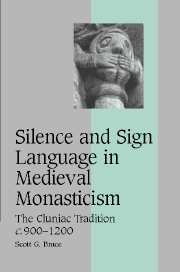Book contents
- Frontmatter
- Contents
- List of tables
- Acknowledgments
- List of abbreviations
- Map
- INTRODUCTION: THE DORMANT LANGUAGE
- 1 UTTERING NO HUMAN SOUND
- 2 THE TRAINING OF THE HAND
- 3 A SILENT COMMERCE OF SIGNS
- 4 TRANSMISSION AND ADAPTATION
- 5 CONTINUITY AND CRITICISM
- CONCLUSION
- Appendix A: The Cluniac sign lexicon
- Bibliography
- Index
- Cambridge Studies in Medieval Life and Thought Fourth Series
Appendix A: The Cluniac sign lexicon
Published online by Cambridge University Press: 16 July 2009
- Frontmatter
- Contents
- List of tables
- Acknowledgments
- List of abbreviations
- Map
- INTRODUCTION: THE DORMANT LANGUAGE
- 1 UTTERING NO HUMAN SOUND
- 2 THE TRAINING OF THE HAND
- 3 A SILENT COMMERCE OF SIGNS
- 4 TRANSMISSION AND ADAPTATION
- 5 CONTINUITY AND CRITICISM
- CONCLUSION
- Appendix A: The Cluniac sign lexicon
- Bibliography
- Index
- Cambridge Studies in Medieval Life and Thought Fourth Series
Summary
This translation of the Cluniac sign lexicon is based on the edition of Walter Jarecki, Signa Loquendi (Baden-Baden, 1981), pp. 121–142. Numerical markers did not accompany the sign descriptions in the customaries of Bernard (1.17) and Ulrich (2.4), but they have been added here to facilitate reference to individual signs.
LET ME SET DOWN SOME THINGS CONCERNING THESE SIGNS, BY GRACE OF THE WORD, AND FIRST, THOSE PERTAINING TO FOOD
[1] For the sign of bread, make a complete circle using each thumb and the next two fingers, the reason being that bread is usually round. [2] For the sign of bread cooked in water and considered better than ordinary bread, add to the aforesaid general sign for bread that you place the palm of one hand over the outside of the other hand and move the uppermost hand around as though smearing or moistening (something). [3] For the sign of wheat bread that is commonly called twisted loaf, add to the aforesaid general sign for bread that you make a cross through the center of your palm, the reason being that this kind of bread is usually divided into squares. [4] For the sign of a small loaf given beyond the usual measure on the five principal feast days, slightly divide the two fingers that follow the thumb and place them obliquely over the same two fingers on the other hand divided in the same way.
Information
- Type
- Chapter
- Information
- Silence and Sign Language in Medieval MonasticismThe Cluniac Tradition, c.900–1200, pp. 177 - 182Publisher: Cambridge University PressPrint publication year: 2007
